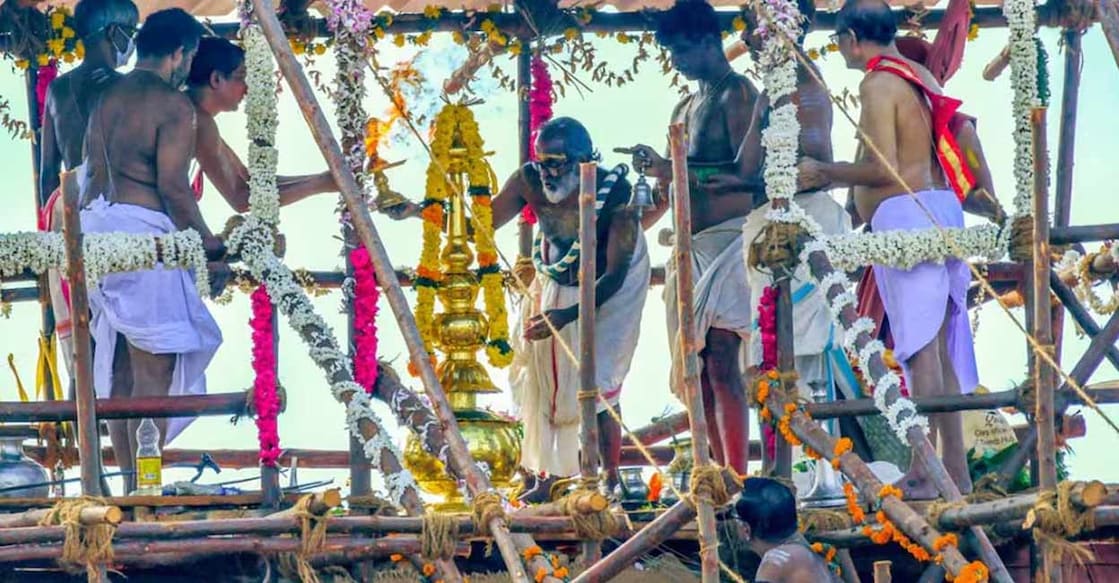'Kumbhabhishekam’ performed at Sree Padmanabha Temple after 275 years

Mail This Article
Thiruvananthapuram: The Sree Padmanabhaswamy Temple in Thiruvananthapuram witnessed the ‘stoopika prathishata maha kumbhabhishekam’ ritual after 275 years on Sunday. Along with the kumbhabhishekam, the reinstallation of the 300-year-old idol of Vishwaksena and the ‘ashtabandha kalasam’ ceremony at Thiruvambadi Sree Krishna Swamy Temple also took place. The kumbhabhishekam was conducted amid the chanting of ‘nama japam’ (divine name) in the presence of numerous devotees.
The day’s rituals started at 7 am, when Moolam Thirunal Rama Varma, the hereditary custodian of Sree Padmanabhaswamy Temple, reached the Thiruvambadi Sree Krishna Swamy shrine on the premises through the Seevelipura from below the chembaka tree and conducted the ‘ashtabandham’ ceremony.’ This ritual involves fixing the idol and its pedestal using eight items – a white conch of medium size, ‘kadukka’ (a variety of fruit), ‘chenchalyam’ (an ayurvedic plant), ‘kolarakku’ (shellac), ‘kozhiparal’, ‘perattumanal’ (types of sand), large guava and sesame oil.
The reinstallation (‘punapratishta’) ceremony at the Vishwaksena shrine adjacent to the main sanctum sanctorum (‘sreekovil’) followed. Subsequently, the ‘kumbhabhishekam’ was performed, during which three golden ‘thazhikakkudams’ (decorative pots) filled with ‘njavara’ paddy were installed above the ‘sreekovil’ and one on top of the ‘ottakkal mandapam’ (single-stone platform) at the temple. Each thazhikakkudam was filled with 25 ‘paras’ of paddy which, as per custom, should be used as seed by the coming generations during a flood or famine.
‘Tanthri’ (chief priest) of the temple Tharanalloor Satheesan Namboodiripad led the rituals in the presence of Kerala Governor Rajendra Arlekar. Priests Tharanalloor N R Pradeep Namboodiripad and Tharanalloor Saji Namboodiripad assisted in the ceremony. Others present on the occasion included Vilwamangalam Swamiyar, Yogathu Pottis, members of the temple administrative committee Adithya Varma, Karamana Jayan and A Velappan Nair, executive officer B Mahesh and manager B Sreekumar.
As per belief, Sree Padmanabha is the guardian of Thiruvananthapuram city and the presiding deity of the erstwhile kingdom of Travancore. The ‘maha kumbhabhishekam’ was performed to overcome all kinds of deprivation and usher in prosperity as well as progress to the land and its people. Centuries ago, the old ‘thazhikakkudams’ were filled with ‘thina’ (foxtail millet). Temple authorities said that when the old ‘thazhikakkudams’ were removed for their reinstallation, the grains were found undamaged.
Vishwaksena, whose idol was reinstalled after 300 years, is considered another form of Maha Vishnu. As per tradition, details regarding the expenses for all rituals at the temple are initially submitted before Vishwaksena. The deity is also considered the sentry to all the wealth belonging to Sree Padmanabha. The Vishwaksena idol is installed in a separate shrine on the northeast corner of the ottakkal mandapam, and faces the south.
The ancient Vishwaksena idol was prepared in ‘kadu sarkara yogam’ (a unique technique of sculpting temple idols). Under this method, various natural elements are utilized to create different parts of the idol. Wood of the ‘karingali’ tree is used to build the bone skeleton of the deity and it is connected with coir (symbolizing nerves and blood vessels) and metal (for hands and fingers). After installing the skeleton (‘soola prathishata’), the remaining parts of the idol are built with a traditional mixture called ‘kadulkarkoottu.’
The renovation at Sree Padmanabhaswamy Temple was carried out based on the recommendations of a panel of experts appointed by the Supreme Court in 2017. Though there was a delay due to various reasons, including COVID-19, the multi-phase work resumed in 2021.

